Editor’s note: This annual assembly on school history is informally known as the “Button Speech,” a reference to founders Samuel and Emily Williston and their manufacturing business (although buttons themselves are not usually the focus). This year, Williston Archivist Rick Teller ’70 spoke during Upper School assembly on September 23. 2015. For the first time, the annual speech also included archival photos, included here.
Good morning. To begin, I’d like you to chew on a few words by the American poet Walt Whitman. No, Walt didn’t go to Williston. As a matter of fact, in the 1850s, when he wrote this, Williston students didn’t study English. (Things change.) Mr. Whitman wrote,
I know that the past was great and the future will be great,
And I know that both curiously conjoint in the present time . . .
And that where I am, or you are, this present day, there is the center of all days.
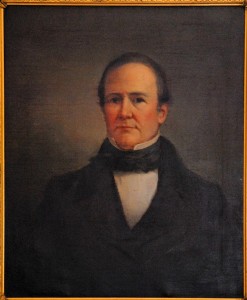
Let’s talk about the early history of the school. As you probably know, what was once called Williston Seminary was founded in 1841 by Easthampton native Samuel Williston, who earned a lot of money making buttons and elastic. But while our hearts yearn for him (for his campus and his geriatric elm), Mr. Williston is going to lurk in the background this morning. There will be other occasions, like Founders’ Day, to get to know him better. And you can always come talk with me.
In the beginning, a Williston Seminary student would have enrolled in one of two divisions. There was a Classical Department, which provided the traditional grounding in Greek and Latin, that would prepare students for university and, perhaps, the ministry. More innovative, and closest to Mr. Williston’s heart was the Scientific Department, in which students who did not plan to go to college could get a thorough education in engineering, mathematics, surveying — everything needed to enter the professions necessary to build a young nation’s growing industrial base. This was an innovative notion in 1841.
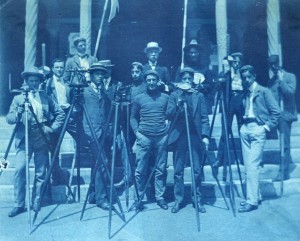
As his first principal, or headmaster, Mr. Williston hired his boyhood friend Luther Wright who, a few years earlier, had instituted a similar dual curriculum at Leicester Academy, not far from Worcester. Mr. Wright was a clergyman and stern, no-nonsense classics teacher who ran the school much as Mr. Williston expected his plant managers to run the factories—so much so that the faculty called him “Boss Wright” behind his back. Mr. Wright had little patience for students or teachers whose ideas differed from his own. He was succeeded in 1849 by Josiah Clark, a fine scholar who was a bit more flexible—or perhaps more realistic.
In the beginning we were coeducational. Samuel Williston thought that girls were a distraction and didn’t really approve. But it made fiscal sense and, as it turned out, was a popular gesture to the town of Easthampton, which still didn’t have a high school. In 1864, Mr. Williston built one for the town, and the Seminary became all-male. It would remain so for 107 years.
The original campus was located down on Main Street, on land now occupied by two banks and Big E’s Supermarket. There were originally two buildings. One burned, disastrously, in 1857, and was quickly replaced by two others.
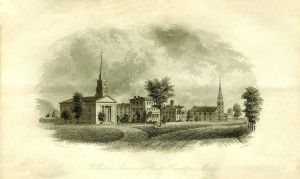
In the middle 1800s, there was no sense of the school’s round-the-clock involvement in every aspect of student life. Students went to their recitations—you would call them classes. In the earliest years, everything happened simultaneously in one huge room. But except for required daily religious services, students were on their own. School-sponsored activities and sports were nonexistent, or rather, it was up to students to devise them. This they did, often meeting resistance from faculty who preferred peace and quiet. But it is remarkable to note that by the 1860s there was, for example, an extensive sports program, all entirely managed and funded by the students themselves.
In 1863, Principal Clark admitted that after 14 years he could not live up to Mr. Williston’s expectations, so he resigned. Enter Marshall Henshaw. Our third principal, and the first of our great heads, learned upon his arrival that Mr. Williston was discouraged and planned to close the school. Mr. Williston’s chief complaint was that his beloved Science Academy was generally considered mediocre. The first two heads had done little more than follow his instructions, and Mr. Williston, business wizard though he was, didn’t know thing one about running a successful school.
Mr. Henshaw convinced Mr. Williston to leave education to educators. What was really required was a large infusion of cash— that, Mr. Williston understood—and some independence. Perhaps no partnership has had more immediate success than Mr. Henshaw and Mr. Williston. In a short time they had expanded the curriculum, raised the standards, enlarged the faculty and student body, and purchased the finest scientific apparatus in the country, some of which remains on exhibit in Scott Hall. And in 1864, they built a gymnasium—the first of its kind in any American high school. All this while the country was engulfed by Civil War. In fact, one of the arguments for building the gym was that it would provide indoor space for the student militia to drill.
The Williston principal answered to a Board of Trustees. The role of the trustees in a school like this is to provide direction for the school’s current programs and future development. They are responsible for overseeing the school’s financial affairs, and for hiring the head. In the early years the board was largely comprised of Samuel Williston’s friends and relations, and there was no question where the power lay, or whose vision was being acted upon. Meanwhile, Mr. Williston paid off the school’s substantial deficit every year. The first two principals could be relied on to do what they were told. Marshall Henshaw was his own man but, precisely because he had stood up to Mr. Williston, had become a close friend.
Then, in 1874, Mr. Williston died. With him died the certainty that the school’s bills would be paid. Mr. Williston had provided for Williston Seminary in his will, but much of his legacy was in securities that would not mature or produce income for many years. The fact was, he had suffered some business reverses toward the end of his life and there wasn’t much cash around. His widow, Emily, had extensive charitable interests, but the Seminary wasn’t among them. The school soon ran out of money. A faction on the board saw Principal Henshaw as having been too close to the founder, thus inhibiting their own influence, and managed to make Mr. Henshaw the scapegoat for the deficit. In 1876, they forced his resignation.
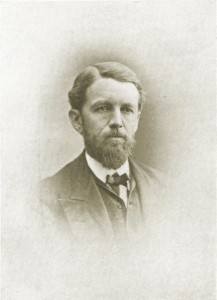
Which brings us to the short, unhappy reign of James Morris Whiton. What can one say about a man so fundamentally unsuited to his job? In fairness, Mr. Whiton arrived already handicapped by having to follow the much-loved and badly treated Mr. Henshaw. He had come highly recommended from Hopkins Grammar in New Haven. In retrospect, Hopkins must have been happy to be rid of him.
Much of the detail from this period may be found in a scrapbook kept by a student named Herbert Plimpton, Class of 1878, who devoted much effort to tormenting Mr. Whiton and recording the results. The events memorialized in Mr. Plimpton’s scrapbook suggest that Mr. Whiton was an obsessive controller with no sense of humor, who didn’t like students very much. Well, they didn’t like him, either—and he never quite figured that out. It was a recipe for chaos. As Mr. Whiton imposed one idiotic regulation after another, student response escalated from merely ignoring him to actively undermining his authority.
The final crisis came in April of 1878. It began with a silly joke. Late one night someone painted the pillars on Mr. Whiton’s house to look like barber poles and put up a sign offering haircutting services. According to one account, Mr. Whiton learned of this sitting at breakfast, when someone walked in and demanded a shave. His response was to lock the students in the chapel while their rooms were searched. Paint-spattered clothes were found—possibly planted—and a boy expelled.
To my mind, the students’ response to this is fascinating. They could have caved in; they could have run riot. They did neither. Instead, virtually everyone trooped over to the gym, sat down, and refused to leave. My generation sometimes pretends it invented student protest. But this was in 1878. Two days later, in desperation, Mr. Whiton closed the school for an early spring break.
All this got into the national newspapers, from the New York Times on down. The Utica Herald’s remarks are typical: While decrying the students’ actions, the Herald equally condemned the violation of their privacy, trumpeting that “the moral aspect is bad. Students, though boys, and some of them bad, have the right to expect honorable treatment.” That cliché about any publicity being good publicity was no more true in 1878 than now.
The Trustees demanded that Mr. Whiton restore order. And after vacation, all seemed eerily quiet for a few weeks. But at the spring trustee meeting Mr. Whiton confidently reported that he had succeeded in returning the Seminary to the rule of law. That night, in a field across the street from the hotel where the Trustees were having dinner, pretty much the entire student body turned out for a bonfire at which they burned Mr. Whiton in effigy. To make sure no one missed their point, they printed flyers explaining exactly what they were about. The next morning, the Trustees reconvened and demanded Mr. Whiton’s resignation. He hadn’t lasted two years.
Mr. Whiton, by the way, would go on to a distinguished career as editor, philosopher, and theologian. He would never have another school. Herbert Plimpton, who chronicled the more colorful details of his downfall, became an influential alumnus, for whom a building is named. Now there’s justice for you.
The new principal, Joseph Fairbanks, distinguished himself by being absolutely invisible. There was no question that the Board was in charge. Mr. Fairbanks seemed to have little interest in day-to-day administration, either. Most of that was handled by Joseph Sawyer.
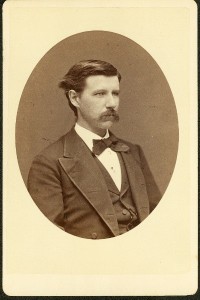
Mr. Sawyer is one of the huge figures in our history. At this juncture he had been on the faculty for 12 years, having been hired in 1866 as a teacher of mathematics and something called “mental philosophy” —we now call it psychology—plus economics and history, and later surveying and English. Teachers had to be multi-talented in those days. They had to be tireless, as well; the typical course load was six one-hour classes, every day. Under Mr. Fairbanks’ minimal leadership, more and more of the daily administrative detail devolved to Mr. Sawyer.
He was so good at it that when, after six years, Mr. Fairbanks resigned, the Board, unable to agree on a successor, appointed Mr. Sawyer as Acting Principal. His understanding was that it was to be for a few months at most. Two years later he felt obliged to remind his handlers that he was supposed to have been temporary. The Reverend William Gallagher was eventually appointed in 1886. In his 10 years at the helm he would be an even greater nonentity than Mr. Fairbanks.
Despite, or perhaps because of administrative indifference, this is a period during which student activity blossomed. Williston was famous for its two rival debating societies, Adelphi and Gamma Sigma, which provided weekly public debates and lectures and were in a real sense the center of campus and town social and intellectual activity. Adelphi began to publish The Willistonian in 1881. It remains the oldest continuously published high school newspaper in the country. Music and theater flourished, and our sports teams—still entirely managed by students—regularly beat college squads. The most popular sports were football and baseball, and a newfangled game that was just catching on: basketball.
In June of 1896, Mr. Gallagher suddenly resigned. The Trustees were faced with finding a Principal on very short notice. Once again, they noted that Mr. Sawyer had been doing most of the work, that he had the respect of teachers and students alike, and that he tended to be uncontroversial. So they appointed him Headmaster. He had never applied for, and didn’t want, the job.
In fact, he was traveling in Europe at the time and didn’t learn of his new role until he returned to Easthampton. He protested that his health was shaky, that he was, at 54—older at the start of his service than any of his predecessors had been when they left—even that his long association with the school, which the Board considered an advantage, might actually be a drawback. My suspicion is that the Board was counting on Mr. Sawyer’s age, health, and uncontroversial nature to result in a short, uneventful term of service followed by his gracious retirement. They could not have been more wrong.
In 1896, the school was still very much as Samuel Williston had envisioned it. But 55 years had passed. Mr. Williston had been gone for 22 of them. The Board had attempted to preserve Mr. Williston’s vision, but they had done so by manipulating a weak leadership, all the while isolated from the day-to-day issues of educating. The school had undergone little curricular or social evolution in 30 years, the finances were a mess, and enrollment was unstable at best. Mr. Sawyer reluctantly hung his coat in the front office and got to work. His first task must have been to convince the Trustees to let him work. To its credit, the Board, many of whose more assertively conservative members from the post-Samuel years had died or stepped down, was willing to listen. They soon would recognize that Mr. Sawyer had what no Williston leader had shown since Mr. Henshaw: vision.
The educational demands of universities and the workplace had changed. The old twin curricula had become less and less relevant. With Mr. Sawyer, a comprehensive curriculum would evolve, resembling something we would recognize today. Mr. Sawyer’s vision of Williston was of an institution which involved its students around the clock. It was thus under his leadership that school-sponsored athletics came into their own, and that the faculty took on substantial social and advisory roles in their students’ lives.
Money, as always, was the real problem. The buildings were aging. Meanwhile, the school was paying for the upkeep of the Williston Homestead property—our present campus—without using it. Mr. Sawyer imposed rigid economies and, after many years, retired the deficit. He also seemed to know something that had escaped his predecessors: that vision and creativity will get you through times of no money, better than money will get you through times of no vision. He had a truly controversial idea, that we take for granted now: asking the alumni for money.
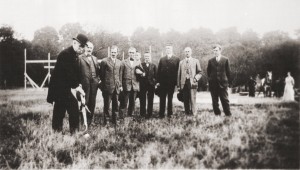
“It won’t work,” he was told. “People think the school is rich and won’t believe it when you ask for contributions.” That turned out to be true. Mr. Sawyer spent 15 years stubbornly trying to convince people otherwise, and was finally successful. A major gift from John Howard Ford led to construction of Ford Hall in 1916—that’s mr. Sawyer at the groundbreaking—opening the new campus to student use, and providing more flexibility in the use of the original school buildings downtown.
And then World War I began. As young men enlisted, and the economy soured, enrollment dropped like a stone. In 1919 there were only 13 seniors at graduation. Without tuition income, deficits mounted quickly. Mr. Sawyer saw all he had worked for crumbling away. Pleading exhaustion, ill health, and advanced age—he was, after all, 77—he tendered his resignation, pending the appointment of a replacement. He had served the school for 53 years, his entire adult life. Mr. Sawyer went home. A few weeks later he was dead.
He would never know that the foundation he had built was solid. With the end of the war, enrollment recovered, his legacy of good management soon had the ledgers in the black, and his school evolved rapidly and positively. Would that he could have seen it.
We’ve reached the 1920s and we haven’t even mentioned Northampton School for Girls, or how we became Williston Academy. But those stories must wait for another time.
So: to be continued… perhaps by me, perhaps by you. Definitely by you! One more poetic reference. We don’t read a lot of Alfred Tennyson any more; back when I was a student we probably read too much of him. There is a poem, “Blow, Bugle, Blow”; it’s posted in the library as the current “Poem of the Week.” (Did you know we have a “Poem of the Week”?) Mr. Tennyson writes of the sound of a bugle echoing in the hills, and in with some nonsense about the horns of Elfland, he writes these extraordinary lines about how echoes
. . . die in yon rich sky,
They faint on hill or field or river:
Our echoes roll from soul to soul,
And grow for ever and for ever.
Go make some history yourselves. Thank you.

